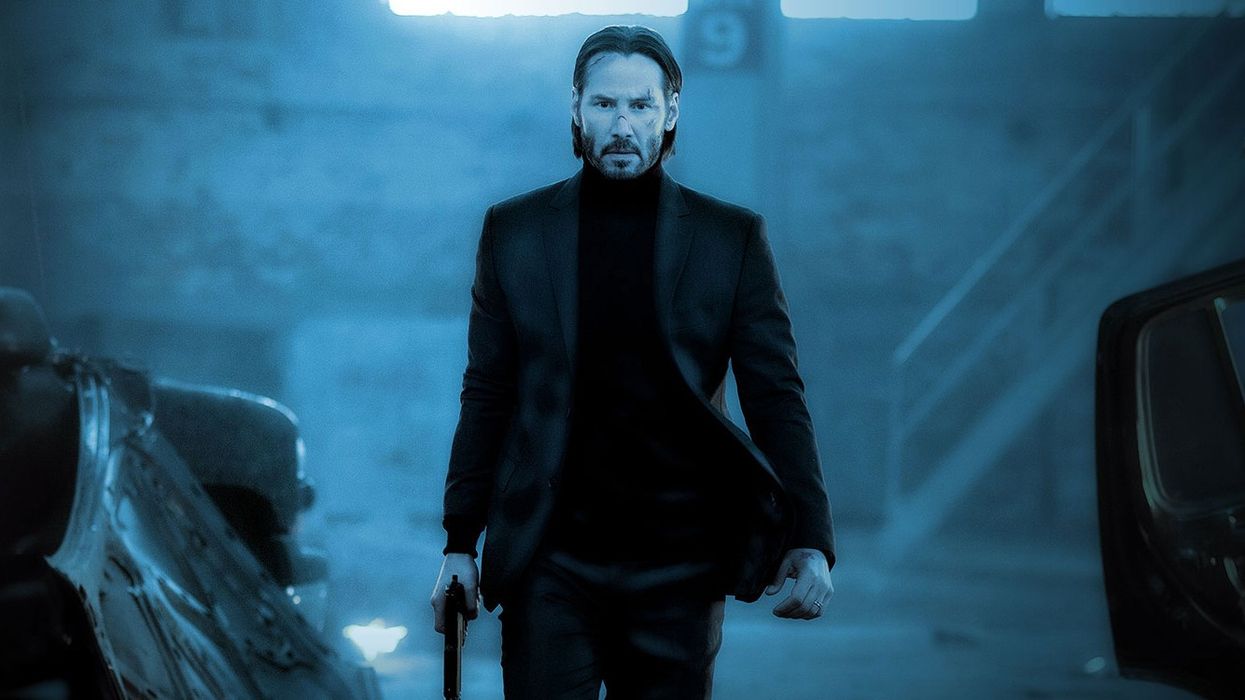Watch: The Surprising Silent Film Techniques Used in 'John Wick 2'
This video essay makes the case that some of the biggest influences on John Wick: Chapter 2 are the great silent comedians.

When one thinks of the ultra-stylized action in John Wick: Chapter 2, the first name that comes to mind might not be Buster Keaton. But, according to Mr Nerdista, Keanu Reeves' performance in the film, directed by former stuntman Chad Stahelski, can be viewed as a sort of canted homage to the deadpan derring-do of legendary silent performers like Keaton, Charlie Chaplin, and Harold Lloyd.
From the first frames of the film, in fact, Keaton literally makes an appearance. Before any of the action has started, we see his image projected, a visual non-sequitur that happens so fast you'll probably miss it, a quick moment from Keaton's 1926 classic The General projected on the side of a building. But what is it doing there?
According to Roger Ebert, for much of his career, Keaton was known as "'"the great stone face,' with an expression that ranged from the impassive to the slightly quizzical," and Nerdista sees a parallel between the work of Keaton, Chaplin, and Lloyd, all of which were highly kinetic and not at all "naturalistic," and the work of Reeves, whose performance as a grief stricken killer, shut down emotionally, relies more on "movement and innate determination," than traditional notions of range. Granted, Reeves has never been the most emotive of actors, but he is a terrific physical performer, and at the age of 52 is still performing all his own stunts. Furthermore, the great silent comedians created a cinema of action, where "every bit of movement had to be coordinated [and] you had to be able to tell your story using your body."
In John Wick, one of the more impressive set pieces (among several), is this highly stylized, choreographed gunfight inside a house of mirrors. Yes, this has been done many times; to name just one example, and a rather obscure one, a variation of the scene appears in Woody Allen's Manhattan Murder Mystery as an homage to a similar sequence in Orson Welles' classic The Lady From Shanghai. And on and on.
Given the context, though, the reference appears to be to perhaps the earliest, ur-mirror maze in all of cinema, being this sequence from Charlie Chaplin's 1928 film,The Circus, which earned him his first Academy Award (before the trophies were known as Oscars):
As Nerdista puts it, "Chaplin's Tramp character clearly influences the grieving John Wick. Both are pulled out of their comfort zone by extenuating circumstances, both were forced to quickly adapt to the situation at hand. It's no coincidence then that both movies share an extensive mirror scene—a moment where both characters are trapped by their own reflection."
"Chaplin's Tramp character clearly influences the grieving John Wick."
Of course, it's possible to extrapolate and connect the dots between any number of films, and one person's interpretation can be judged just as valid as anyone else's. But that's no fun, really, and when you add up all of the examples given here, the essay makes a convincing case that that the character of John Wick, as embodied by Keanu Reeves, is not a typical action hero, and that his lack of affect is a carefully calculated strategy which the filmmaker (himself a former stuntman) uses in order to meld the silent stunt spectaculars with their modern day counterpart.
And it's not only Reeves who performs his own stunts: his co-stars, Ruby Rose and Common, also bring a physical verisimilitude to the proceedings.
As the essay puts it, "[the] franchise elicits laughs courtesy of Reeves' dialogue....A film so beautifully ingrained in and influenced by classic cinema would obviously look to find comedy wherever possible," and where it gets it is from quiet moments of high stylization and the contrast between such rococo surroundings and a purposefully expressionless hero, riffing on his own reputation. It's genuinely pretty weird, for an "action" movie.
Like them or not, the John Wick films, and the character, as played by Reeves, have more going on beneath the surface than one would think. Instead of a psychology of motivation, John Wick has a psychology of movement , and that is, arguably, a more honest cinematic deployment of action than the countless heroes and heroines whose body counts are the result of spurious psychological wounds about which they pontificate at carefully spaced moments between acts.
Nerdista has done his homework here, and lest we forget, in their day, Keaton and Chaplin were fairly commercial entertainers; their use here is far from cinematic sacrilege. If nothing else, the deployment of these silent stars in Wick demonstrates the fluidity of cinema, and is another example of the never-ending parade of allusions that flicker across on the silver screen, connecting one century to the next.
Source: Mr Nerdista













